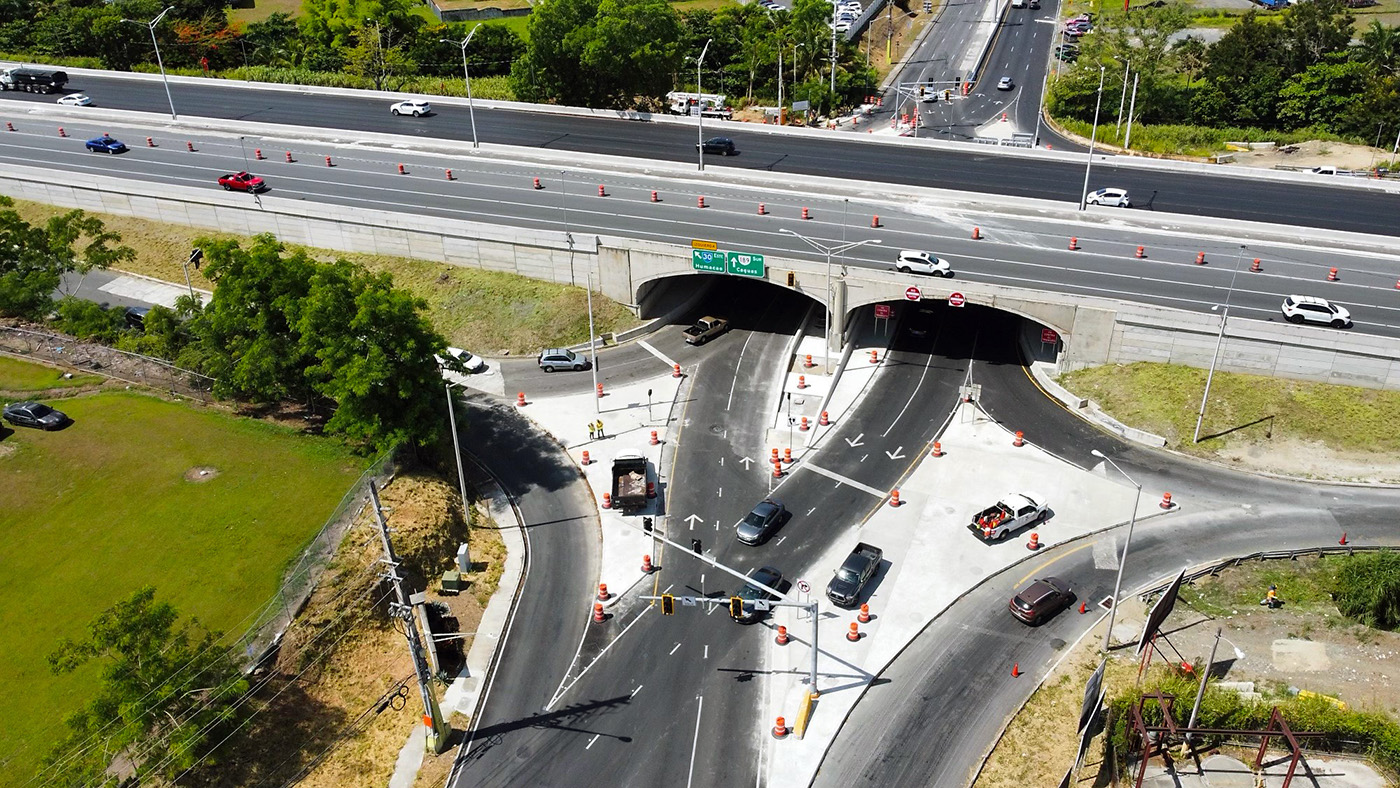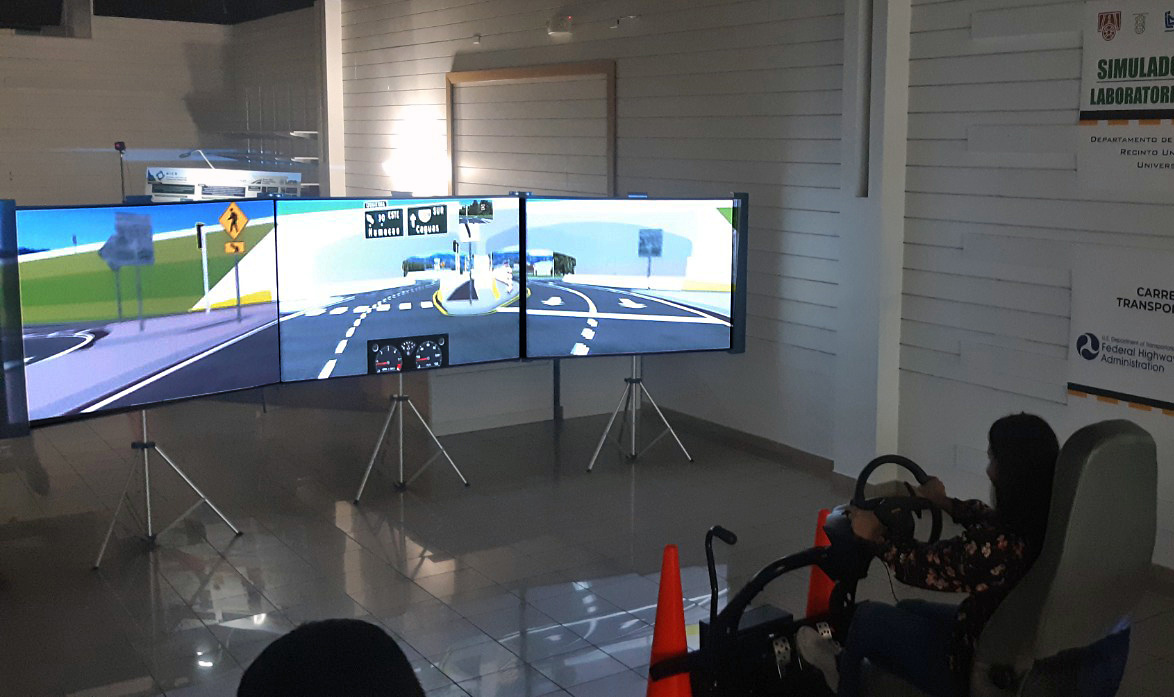
From Simulation to Reality: Puerto Rico’s First Diverging Diamond Interchange
Fatal and injury crashes often occur at or near intersections as motorists, pedestrians, and bicyclists cross paths. During Every Day Counts round 2 (EDC-2), FHWA encouraged transportation agencies to consider several innovative intersection and interchange designs that can accommodate traffic volumes efficiently while reducing or altering conflict points to allow for safer travel.
One of these configurations is a crossover-based design called a diverging diamond interchange (DDI). DDIs eliminate the signalized left-turn phase within an interchange by shifting the crossroad traffic to the left side of the roadway between the ramp terminals. Compared to a conventional diamond interchange, the DDI reduces vehicle-to-vehicle conflict points by nearly 50 percent.
Driving Simulation Studies Enhance Design
The Puerto Rico Highway and Transportation Authority (PRHTA) planned what became the island’s first DDI as part of a bridge replacement project in the municipality of Gurabo. PRHTA proposed the DDI as a pilot project to improve the safety and operation of the interchange, which sees a high volume of traffic due to a nearby university, industrial park, and residential developments.
After learning that researchers from the University of Puerto Rico at Mayagüez previously employed a driving simulator to study the use of a dynamic toll lane on one of Puerto Rico’s main highways, staff from the FHWA Puerto Rico Division Office suggested PRHTA integrate a driving simulation tool during the design of the new DDI.
“Division staff felt strongly enough about the benefits and results from the use of the driving simulation tool that they recommended it to PRHTA for studying the proposed DDI,” said Juan Rivera Ortiz, highway engineer at FHWA’s Puerto Rico Division Office. “The PRHTA accepted the recommendation,” he said, “and so the collaboration became a part of the process to evaluate the DDI design and provide recommendations on how to improve signing and pavement marking.”
University researchers successfully developed the simulation based off the project plans. They moved the driving simulator to a location close to the project and conducted research with more than 50 local drivers, who provided feedback on the traffic control devices in the DDI. The university developed a report with several recommendations for additional traffic signs and better pavement markings for the intersection.

An aerial view of Puerto Rico’s first diverging diamond interchange.
Credit: Puerto Rico Highway and Transportation AuthorityThe design team discussed the recommendations and revised the design accordingly. One recommendation to add overhead signs to the DDI benefited significantly from the use of the driving simulator. Because this change would require installing additional structural support at the interchange, the initial review of the design using the driving simulator helped avoid the costly retrofits that would have been necessary later had the overhead signs been installed after the DDI opened to the public.
The researchers updated the design plan in the simulator and then conducted a second investigation with local drivers, including police officers and emergency medical services (EMS) personnel. This investigation resulted in a second report and set of recommendations, which the design team incorporated into another revised plan prior to the opening of the project.

Driving simulation experiments helped inform the design of the new diverging diamond interchange as well as the communication plan.
Credit: University of Puerto Rico at MayagüezSimulation Results Support Community Outreach
One challenge with implementing a new intersection or interchange design for the first time in a community is the lack of familiarity among users. In this case, the project team was able to leverage the driving simulation results in developing a communication plan aimed at reducing driver confusion with the new DDI traffic pattern.
With the approval and support of PRHTA executive management, the communication plan described the DDI design and explained its benefits to the public through TV, radio, and social networks. PRHTA also developed a brochure explaining how to drive through the DDI and distributed it to local drivers at the intersection.
The research team made the driving simulator available to citizens and provided them with information on how to drive through a DDI during outreach efforts at the main shopping centers and at professional conferences. The research team also produced an educational video using images from the driving simulator and made it available to view on the web.
Prior to the opening of the DDI, the PRHTA traffic incident management (TIM) team conducted a tabletop exercise to prepare in the event of a major crash or incident in the area. During the exercise, personnel from the local police department, EMS, public works department, and others discussed various scenarios and how to manage detours and lane closures during incidents, which led to a recommendation to add two closed-circuit television cameras at the intersection. Staff at the PRHTA Transportation Management Center can now view the live camera feed to facilitate immediate feedback with the TIM team.
The DDI opened to traffic on May 29, 2023, during the last phase of construction. Rivera Ortiz said that, despite some initial driver confusion, the DDI is now working well, thanks in part to the simulation experiments that informed the design, the agency collaborations, and the communication plan.
—MORE INFORMATION
Read a technical report on Puerto Rico’s DDI to learn more about the benefits of using a driving simulator as a tool for evaluating the design.
Visit the FHWA’s intersection safety webpage.
Contact Juan Rivera Ortiz, FHWA Puerto Rico Division Office, or Mark Doctor, FHWA Resource Center, for information and technical assistance.
Disclaimer: The U.S. Government does not endorse products or manufacturers. Trademarks or manufacturers’ names appear in this document only because they are considered essential to the objective of the document. They are included for informational purposes only and are not intended to reflect a preference, approval, or endorsement of any one product or entity.
Except for the statutes and regulations cited, the contents of this document do not have the force and effect of law and are not meant to bind the States or the public in any way. This document is intended only to provide information regarding existing requirements under the law or agency policies.
Recommended Citation: U.S. Department of Transportation, Federal Highway Administration - Washington, DC (2025) Innovator Newsletter, March/April 2025, Volume 18 (103). https://doi.org/10.21949/xj4k-9v21
- Cover
- From Simulation to Reality: Puerto Rico’s First Diverging Diamond Interchange
- Concrete Innovation: ODOT’s Strategic Approach to Internal Curing
- EDC Legacy: Collaborating to Solve Road Data Challenges
- Systemic Safety Analysis: The Power of Prevention
- States Innovate
- Enhance Concrete Performance with Internal Curing
- About Innovator



